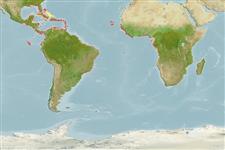Common names from other countries
Environment: milieu / climate zone / depth range / distribution range
Ecologia
; estuarina; intervalo de profundidade 0 - 2 m (Ref. 101599). Tropical; 33°N - 30°S, 98°W - 14°E
Atlantic Ocean: from Florida to Bermuda, Mexico, Belize, Panama, the Antilles, Colombia, Venezuela, the Guianas, to Brazil (Para to Santa Catarina, including Fernando de Noronha), and the eastern Atlantic, from Senegal to Angola.
Length at first maturity / Tamanho / Peso / Idade
Maturity: Lm 2.5, range 2 - 2.9 cm Max length : 5.6 cm CW macho/indeterminado; (Ref. 102095); 5.1 cm CW (female)
Inhabits brackish muddy waters, often in mangrove swamps (Ref. 435), able to move fast between the roots and trunks of trees (Ref. 104080). Found in burrows (Ref. 86356), from intertidal to supratidal waters (Ref. 97531). Excellent predator in the mangroves (Ref. 104080). Feeds on mangrove propagules and animal matter (Ref. 86356). First marine crab reported to feed on an amphibian Leptodactylus macrosternum, wherein the frog was found near the crab's burrow (Ref. 104080).
Fischer, W., G. Bianchi and W.B. Scott (eds.). 1981. (Ref. 435)
Categoria na Lista Vermelha da IUCN (Ref. 130435)
Categoria CITES (Ref. 108899)
Not Evaluated
Not Evaluated
Utilização humana
Pescarias: espécies comerciais
| FishSource |
Ferramentas
Fontes da internet
Estimates based on models
Preferred temperature
(Ref.
115969): 25.2 - 28.1, mean 27.4 (based on 644 cells).
Resiliência
Elevada, tempo mínimo de duplicação da população menor que 15 meses (K=2.24-2.5; tm=0.23).
Vulnerabilidade
Low vulnerability (10 of 100).
Categoria de preço
Unknown.
